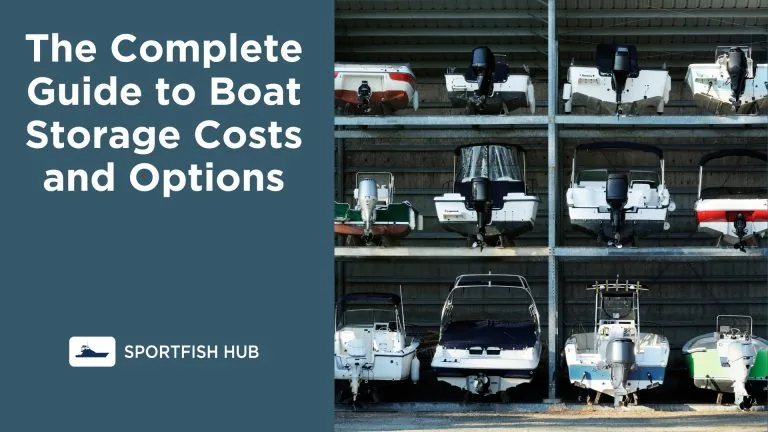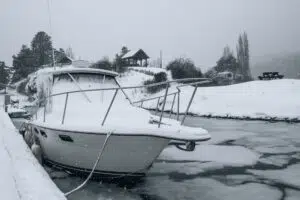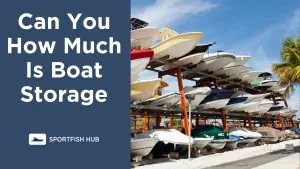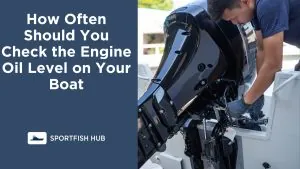Storing your boat properly is key to protecting your investment and ensuring it’s ready to go when you are. This guide covers the pros and cons of various boat storage costs, options, and tips for choosing the right solution for your needs and budget.
Key Takeaways
- Average boat storage costs range from $50-$250 per month depending on location, size of boat, type of storage, and service used.
- Popular boating locations with high demand generally have higher storage costs.
- Larger boats require more space, which costs more for storage. Figure at least 5 ft longer than the boat.
- Outdoor uncovered storage is the cheapest option at $50-$100/month but provides less protection from the elements.
- Indoor or covered storage is recommended for winter to protect boats from damage. Cost is around $50/ft.
- Winter storage for a 25 feet boat at an indoor facility can cost over $1000 for the season.
- Storing on land is cheaper than keeping a boat in the water, but less convenient access.
- To protect stored boats, use shrink wrap, boat covers, winterize systems, charge batteries, and avoid leaks.
- Check with private owners on services like Neighbor to find deals on storage versus marina prices.
Table of Contents
- Key Takeaways
- Average Boat Storage Costs
- Factors Impacting Boat Storage Costs
- Tips for Choosing Boat Storage
- Key Factors When Evaluating Where To Store Your Boat
- Planning for Winter Boat Storage
- What to Expect with Indoor Storage Facilities
- Storing Your Boat on Land vs in the Water
- Finding Affordable Options for Boat and RV Storage
- Key Tips for Protecting Your Boat in Storage
Average Boat Storage Costs
The average cost to store a boat ranges from $50-$250 per month, depending on:
- Location – Coastal regions with high demand charge more. Inland lakes charge less.
- Size – Larger boats need bigger spaces, which cost more. Figure at least 5 feet longer than the boat.
- Type – Outdoor uncovered is cheapest. Indoor is most expensive but most secure.
- Service – Marinas charge more. Private owners on sites like Neighbor offer deals.
Figure about $100/month for a 20 ft boat. Bigger boats can run up to $250/month for indoor storage.
Factors Impacting Boat Storage Costs
Location
Popular boating areas like Florida have higher demand so storage costs more. Landlocked places like Pennsylvania have fewer specialized options and lower prices.
Size
Bigger boats need more space. Figure storage size 5 feet longer than the boat.
| Boat Length | Ideal Storage Size | Average Monthly Cost |
|---|---|---|
| 8-15 ft | 15-20 ft | $90-$200 |
| 15-25 ft | 25-30 ft | $100-$220 |
| 25+ ft | 30 ft+ | $150-$250 |
Type of Storage
In-Water
Also called wet slip storage. Costs $25-$50 per foot per month. Convenient since you can access the boat year-round but requires haul out for maintenance.
Uncovered Outdoor
Cheapest at $50-$100/month but exposes the boat to elements. Must use a cover. Easy to find storage lots but not boat-specific.
Covered Outdoor
$75-$150/month. Provides cover from sun/rain but still outdoors. Carport is an option. Storage with Neighbor is affordable.
Indoor
Most expensive at $100-$250/month but most secure. Self-storage, warehouses, and dry stacked common options. Allows maintenance without haul out.
Tips for Choosing Boat Storage
- Consider convenience of location if you boat frequently
- Allow room for maintenance – avoid cramped spaces
- Assess protection level needed – indoor best for harsh weather
- Look beyond marinas for deals from private owners on Neighbor
- Use a trailer for outdoor storage to allow mobililty
- Add a boat cover for outdoor storage to protect from sun/rain
- Discuss any electrical needs for maintenance beforehand
- Ensure outdoor storage is fully secure – look for fencing/cameras
- Have a maintenance plan for checking systems, charging batteries, etc.
- Ask about launch and retrieval services if available
Key Factors When Evaluating Where To Store Your Boat
| Factor | Description |
|---|---|
| Convenience | Distance to home and water access when boating |
| Size | Ensure enough room for easy access and maintenance |
| Security | Look for secure fences, gates, lighting, surveillance |
| Protection | Consider weather and cover needed |
| Cost | Get quotes from multiple facilities and private owners |
| Services | Inquire about launch/retrieval, winterization options |
| Accessibility | Ability to get the boat in/out when needed |
Finding the right boat storage solution requires weighing your needs, convenience, costs, and the level of protection necessary. Do your research to find the optimal blend of affordability and security for your specific situation.
Planning for Winter Boat Storage
Many boat owners opt for indoor or covered storage facilities during the winter months to keep their vessels protected from the elements. This is especially important in colder climates where boats left outdoors or in the water can sustain damage from freezing temperatures, snow, and ice.
What to Expect with Indoor Storage Facilities
Indoor storage facilities like marinas often charge around $50 per foot for winter storage rates. For a large boat that’s 25 feet long, you may need to budget up to $1,250 for a full winter of indoor storage. Storage facilities will often offer additional services like shrink-wrapping your boat or winterizing motors and systems. Make sure to inquire about all costs before committing.
Storing Your Boat on Land vs in the Water
Storing your boat in the water is convenient if you want year-long access, but can cost thousands per year at local marinas. Many boat owners opt for dry storage on land during winter months. This keeps your boat protected and you won’t have to worry about ice damage. Just make sure you have a plan to transport your boat and trailer to the storage facility.
Finding Affordable Options for Boat and RV Storage
The cost of off-season boat storage depends on many variables, but indoor units will generally be the most expensive option. If you’re looking to save on storage, consider covered outdoor storage which will still keep your boat protected. Outdoor storage spaces rented from private owners through services like Neighbor are also often much cheaper than traditional boat storage facilities.
Key Tips for Protecting Your Boat in Storage
- Use shrink wrap or invest in a boat cover
- Winterize the motor and systems
- Charge batteries monthly and run the engine if possible
- Check for leaks along the hull when storing on land
- Ensure outdoor storage is fully secure with fences and lighting
- Avoid cramped storage spaces – allow room for access
I would place the winter storage information right after the general storage tips section, as winter protection is a key consideration for many boat owners looking for storage. The added sections provide helpful details specifically around winter storage costs, options, and preparation.











